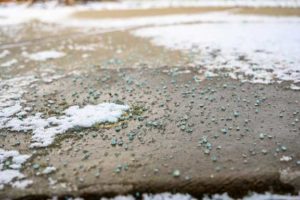
Keeping your commercial parking lot, stairs, and walkways free from slippery ice is an important task during the winter. When these surfaces are covered in ice, employees and patrons can slip and fall on their way into and out of your business, and an ice-covered parking lot can contribute to vehicle collisions.
However, if you are like many business owners, you may not be familiar with ice melts and simply purchase one you have heard of and sprinkle it haphazardly on patches of ice you see on your property. This product may or may not completely melt the ice on your property and may even damage your pavement.
Instead, you should learn about the numerous ice melt types available today and how each works to determine which is best for your climate and pavement types. Read on to learn more about your ice melt options and how they work to aid you in keeping your outdoor surfaces ice-free during the winter.
Liquid or Granular/Pellet Formulations
Commercial ice melts are available in both liquid and solid formulations, and each form has its unique advantages.
Liquid Ice Melts
Liquid ice melt products are typically sprayed onto pavement surfaces before heavy snowfall to prevent ice and snow accumulation before it starts. However, liquid ice melts can also be applied to existing ice accumulation.
Liquid deicers typically work more quickly than solid deicers when applied to existing ice, and many business owners find it easier to cover pavement and ice with an even coating of deicer when it is in liquid form. While liquid ice melts do work very well, they tend to cost more to ship than solid ice melts due to their heavy weights and they take up more storage space than solid ice melts.
Solid Ice Melts
Solid ice melts are available in pellet and granule form and can also be used as both a pavement pre-treatment to prevent snow and ice accumulation and as a treatment to melt existing ice. These products are typically more affordable than liquid melts since they are lightweight and easy to ship. Solid ice melt particles can also increase traction on slippery surfaces.
While solid ice melt products can work very well, they melt ice more slowly than liquid formulas. Solid deicers must first absorb water from the surface of the ice they are melting before penetrating more deeply into the ice to melt it completely.
Choose a solid deicer product made up of round pellets or granules instead of one with irregularly shaped granules. Round deicer particles melt ice more quickly because they tend to penetrate through ice more quickly than solid deicers made up of irregularly shaped particles.
Endothermic or Exothermic Products
Ice melts can be further categorized as either endothermic or exothermic products.
Endothermic deicers pull heat from the air surrounding them and then release this heat into ice accumulation to melt it. On the other hand, exothermic deicers create their own heat that they then utilize to melt the ice they are applied to.
Each ice melt type performs best within a certain temperature range. Endothermic deicers work well when outdoor temperatures are about 20 degrees F or higher because these ice melts do not have a difficult time pulling heat from the air in this temperature range. If outdoor temperatures are below 20 degrees F, an exothermic deicer that creates its own heat is a better ice melt option.
If temperatures in your area frequently drop below 20 degrees F, then keep both ice melt types on hand or use a deicer made up of both endothermic and exothermic deicer particles.
Deicer Chemical Makeup
Many ice melts contain one chemical ingredient, often a mineral, that melts ice effectively, while others are made up of a blend of chemicals. Just a few of the most common ice melt ingredients are as follows.
Sodium Chloride
Sodium chloride deicers are very popular because they are very affordable and work well at temperatures above 20 degrees F. However, like all endothermic deicers, sodium chloride struggles to melt ice when outdoor temperatures drop below this and due to its corrosive nature, this deicer chemical can damage concrete and plants over time.
Calcium Chloride
Calcium chloride is another popular ice melt ingredient that works well when outdoor temperatures are as low as -25 degrees F due to its exothermic properties. This deicer is less likely to damage concrete surfaces and is less toxic to plants than sodium chloride.
Magnesium Chloride
Magnesium chloride is another popular exothermic ice melt, although unlike calcium chloride that works well at lower temperatures, this deicer chemical tends to melt ice effectively at temperatures of 5 degrees F and higher. However, this deicer is also less corrosive than sodium chloride and is considered a more pet-friendly option than both sodium and calcium chloride products.
Additional popular ice melt ingredients include calcium magnesium acetate, urea, potassium chloride, and calcium sulfate, and all have their own unique advantages and disadvantages.
Instead of sprinkling any deicer you can find locally haphazardly on the ice that accumulates on your business parking lot, outdoor stairs, and walkways, choose your ice melt formulation more carefully for more effective results and a safer business exterior during the winter. We offer the SAFEST, MOST POWERFUL De-Icer at affordable prices. Designed for those with a focus on performance as well as protection, these Ice Melters are safe for children, animals & vegetation. Ben’s carries 3 varieties of ice melter that vary from -5 Degrees to -20 Degrees. Contact the ice melt experts at Ben’s Cleaner Sales Inc. to purchase effective commercial ice melt products today.

